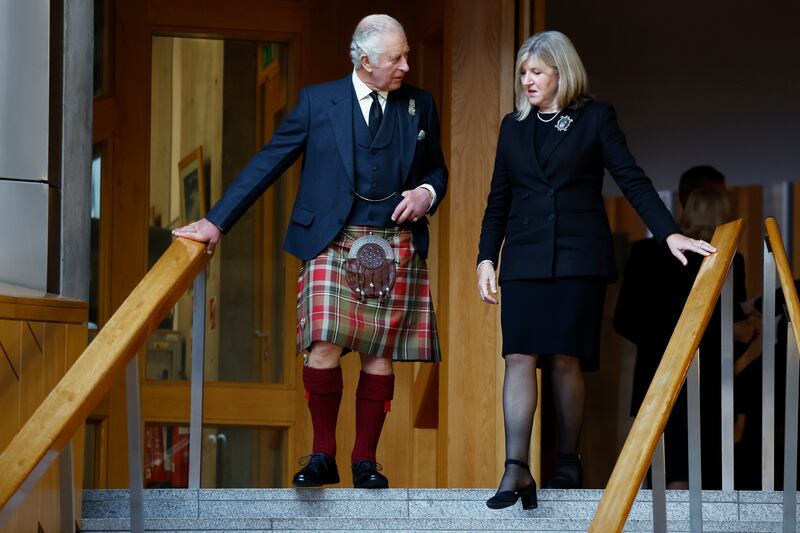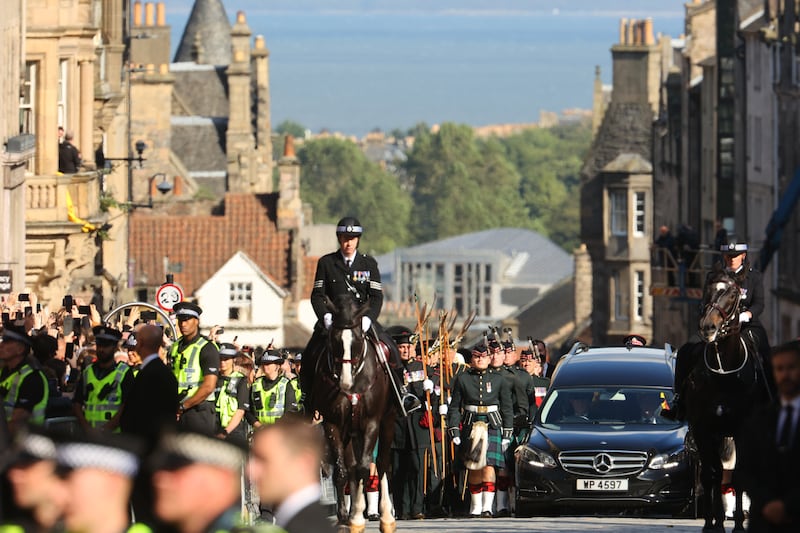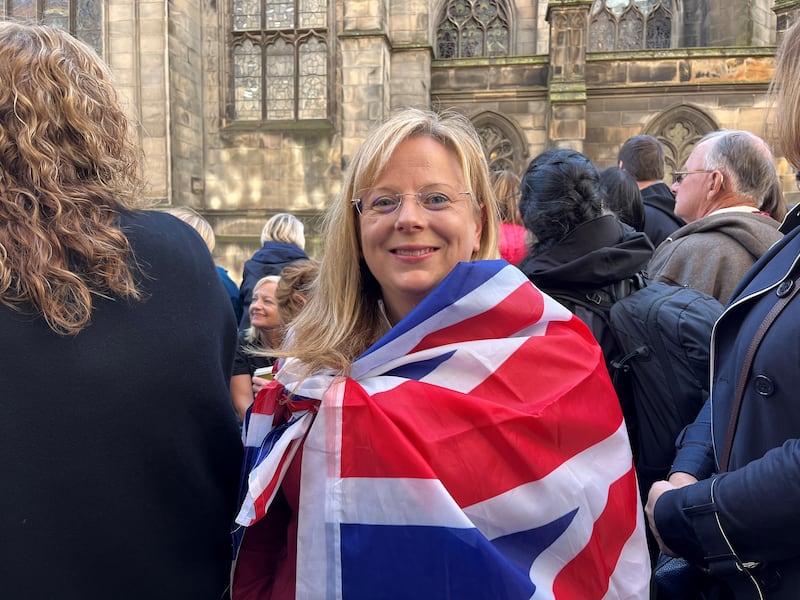Even in the autumn sunshine, the local stone with which much of the city is built can make Edinburgh seem a dark city.
On Monday, the effect is of a city in mourning. On the Royal Mile in the Old Town, the buildings lining the famous route up the hill to Edinburgh Castle seem to lean ever closer than usual, casting a shadow over the crowds waiting below.
Many had been waiting for hours to secure a spot near St Giles’ Cathedral, where the body of Queen Elizabeth is due to be brought in procession from its overnight resting place in the throne room of the palace of Holyroodhouse for a service on Monday afternoon.
“It’s just a historic occasion,” says Claire Coote, who travelled from Ayrshire with her three children, William, James and Alice.
RM Block
“I’ve not been lucky in my lifetime to see the queen, so to come for her last wee journey in Scotland, it felt like the right thing to do and, judging by the crowds, a lot of other people thought the same.”
“I’m not a monarchist but she was an important person,” says her son William (14). “And she was a role model for girls and women,” adds his sister Alice (11).

“I had to come and say ‘bye to the Queen,” says Rita Patton. She and her daughter Angela Summerfield came to Edinburgh from the north of England on Monday morning. “She was the mother of the nation, you can’t imagine her not here,” her daughter adds.
“I do think it’s a shame people in England won’t get this opportunity, but it’s fitting she passed away in Scotland, I think that’s what maybe she wanted.”
[ King Charles pledges to follow mother’s example of ‘selfless duty’Opens in new window ]
By midday, the streets around the cathedral are completely full. People have come from all over the world to be there. Among those watching are visitors from South Africa, the United States and Australia, and alongside them are television crews broadcasting in multiple languages.
There is the occasional verse of God Save the King from the crowd, and a flurry of excitement when a car displaying the Royal Standard conveys the new King Charles III up the Royal Mile towards the palace in advance of their return journey on foot behind the coffin.
Then the dignitaries begin arriving; they include guests wearing ceremonial and military dress and politicians, including Scotland’s former first minister Alex Salmond, and the former UK prime minister Gordon Brown. Dressed in black, they walk in small groups up to the cathedral.
The procession bearing the queen’s coffin is due to leave the palace at 2.30pm. As the time approaches, the anticipation builds in the crowd. At Edinburgh Castle, a 21-gun salute begins, the boom of the guns echoing along the street approximately once every minute.
The first indication the procession is near comes when people in the crowd ahead lift their phones to begin recording.
Then come two black police horses, leading the way; the only sound is the clip-clopping of their hooves on the cobbles.

Flanked by a military guard of honour, the hearse bearing the queen’s coffin makes its way slowly up the Royal Mile to the door of St Giles’ Cathedral, with the new King Charles III and Queen Elizabeth’s other children — Princess Anne, Prince Andrew and Prince Edward — among those walking behind. The crowd applauds as it passes.
Her coffin is carried inside for a church service attended by, among others, Scotland’s first minister, Nicola Sturgeon, and Britain’s new prime minister, Liz Truss, invited to form a government by the queen less than a week ago in what would become her last formal act as monarch.
The queen will lie at rest in the cathedral for the next 24 hours to allow people to file past the coffin; on Tuesday afternoon her remains will be taken to Edinburgh airport and then to London as she leaves Scotland for the last time.
“It was a regal occasion for a regal lady on a regal street, the Royal Mile,” says John Burleigh. Both he and his wife Heather have worn traditional tartan for the occasion.
[ London-Irish centre gave royal couple a right knees-upOpens in new window ]
Draped in a Union Jack, Louise Murphy was among those watching opposite St Giles’ Cathedral as the queen’s coffin arrived.
“The voices of the union aren’t as strong in Scotland, but today shows the union is strong in Scotland — contrary to those who wish to cause division where none exists,” she says.

“Having the opportunity to come out today — and look at the amount of people who are here — this speaks volumes in itself. You can be Scottish and British. You don’t have to be one or the other, you can be both.
“Nicola Sturgeon wants to hold a referendum [on Scottish independence] next October. The queen’s passing now — and passing in Scotland — will bring into sharp focus what the union means to the people of Scotland, and I hope that makes independence less likely.
“People have been reminded of the benefits of the union — and that’s not just monetary, that’s familial connections and shared history.”




















